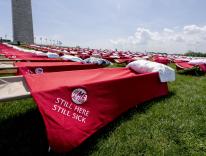At dusk on the eve of the presidential inauguration, Joe Biden, Kamala Harris, and their spouses stood on the National Mall. Behind them glowed the Washington Monument. The reflecting pool was flanked by beams of light. That day, January 19, 2021, marked almost exactly a year to the day since the first reported case of COVID-19 in the United States. It was also the day the country surpassed four hundred thousand deaths from the virus.
“To heal, we must remember,” Biden said during his remarks. “It’s hard, sometimes, to remember. But that’s how we heal.” Vice President Harris echoed the idea that in the face of social trauma, ritual itself is an act of survival. “For many months, we have grieved by ourselves. Tonight, we grieve—and begin healing—together.” They encouraged all Americans to light candles in their windows as an act of collective mourning.
Watching the livestreamed memorial for the victims of the pandemic felt like shaking off the bleary hangover of a nightmare, blinking awake from a cloudy half-reality. In its ordinariness and symbolic familiarity, the ritual seemed like the most obvious act imaginable: right, of course. This is what we should have been doing all along.
In many ways, the service of lament felt like the first honest words we’ve heard about the pandemic from elected leaders. Hundreds of thousands of people have died early, lonely, confusing deaths. We’ve lost jobs and sanity and the consolation of friends, classrooms and communities and rites of passage, the everyday touches and public intimacies of an embodied life. The losses are incalculable. Everything has gone wrong. It has been a terrible year.
The ritual felt true precisely because it avoided the typical rhetoric used to describe our response to the pandemic. Soon after the virus arrived in the United States, the lexicon of war became, predictably, the default way of talking about the situation. Doctors and nurses were “front-line soldiers” in a campaign against an “invisible enemy.” The dead had lost their “battles” with COVID-19. Such language persists in the commentary on vaccine development—“Operation Warp Speed” sounds like a cartoonish riff on a military campaign. In a January 4 interview on National Public Radio, Dr. Leana Wen decried the slow vaccination rollout. “We need a wartime effort,” she emphasized, led by an “army of vaccinators.”
These war metaphors for disease are so ingrained in common speech that it is almost hard to come up with alternatives. Such metaphors have their merits—summoning strength, evoking courage—but they are ultimately inadequate. In her 1978 essay Illness as Metaphor, philosopher Susan Sontag argues that cloaking speech about disease in metaphorical language assigns to pathogens a moral quality and their sufferers a sense of punitive responsibility. Those vanquished in their battles against their internal enemies have perhaps, we can’t help but think, not fought hard enough. They’ve failed.
If the war analogy has proved at all illuminating, it has been primarily in unintended ways. It is revealing, for example, that the phrase “wartime effort” is meant to evoke images of World War II–era scrap metal drives and chambray-clad Rosie the Riveters—and not the wars in the Middle East in which the United States is currently involved. In the twenty-first century, American “wartime efforts” primarily consist of transferring the burden of sacrifice to the shoulders of the poor who fight these wars. Like war, then, the pandemic’s effects have been mediated at nearly every level through human-made structures of inequality.
In a country fixated on individual rights, the lexicon of war can seem like the only language we have for collective action. This is both lamentable and ironic. In different ways, both our ongoing wars and the splintered pandemic response demonstrate that Americans are, by and large, unpracticed at sacrificing for the common good. We like the idea of sacrifice but most often opt for sacrifice-by-proxy. Embracing a kind of warped substitutionary atonement, we call certain classes of people heroes—doctors, nurses, essential workers, soldiers—as though that alone justifies their bearing the burden of death.
Ultimately, the pandemic-as-war comparison is disingenuous. The analogy would have demonstrated its utility had such language successfully fomented support for mobilizing and synchronizing the full resources of the government to stem the virus’s spread. This did not occur. While Congress annually approves hundreds of billions of dollars in military spending, lawmakers had to be cajoled into passing even the most modest pandemic relief. The Defense Production Act—a wartime innovation giving the president power to harness the resources of American industry in order to meet the material needs of a crisis—would have been helpful had it been invoked in a timely, strategic manner. Instead, ever the fan of reality television, Donald Trump took what seemed like perverse delight in watching states battle one another for respirators and PPE. In all its macho energy, the lexicon of war has failed us.
It should come as a relief, I think, to finally admit that the COVID-19 pandemic is nothing like a war. War relies on learned inhumanity. Killing an enemy requires being desensitized to the humanity of both the enemy and oneself. To listen to the words of medical workers and the loved ones of the dead is to confront inescapably the depth of human grief in its rawest form. There is no camouflaging our fragility. Only compassion, solidarity, and love can bring us to the other side of this. In his invocation at the January 19 memorial service, Washington D.C. Cardinal Wilton Gregory said it best: “Our sorrow unites us to one another as a single people with compassionate hearts. May our prayer strengthen our awareness of our common humanity.” As we enter the pandemic’s second year, perhaps it’s time to lay down our armor and approach the work ahead not as an army but as a people.
Please email comments to [email protected] and join the conversation on our Facebook page.
Previous Story
Vaccine Delays
Next Story
The Past Catches up with Postmodernism

